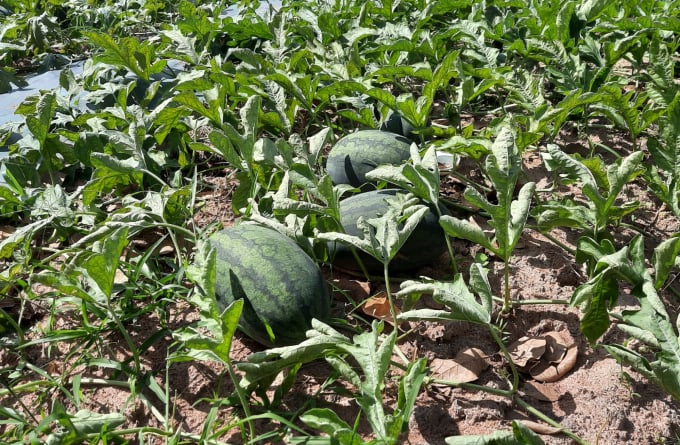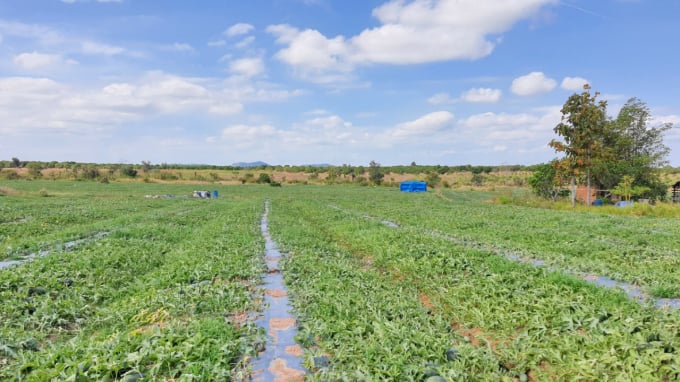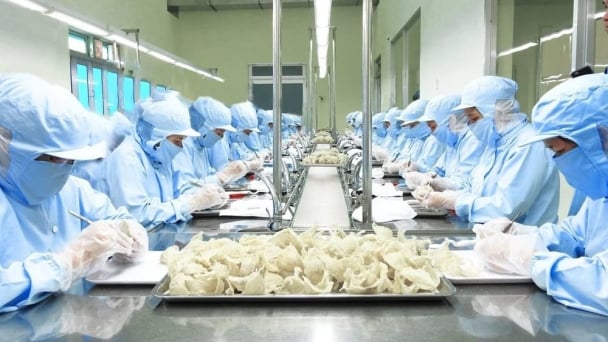May 17, 2025 | 03:52 GMT +7
May 17, 2025 | 03:52 GMT +7
Hotline: 0913.378.918
May 17, 2025 | 03:52 GMT +7
Hotline: 0913.378.918
Three months ago, Tan, a 47 year-old farmer and his wife living in An Nhon town, Binh Dinh province travelled nearly 200km to Ia Lau commune, Chu Prong district, Gia Lai province to hire land for watermelon cultivation. They hired 1.5 hectares of land for more than VND25 million. They set up a shelter by the field and prepared the soil to grow watermelons.

Tan’s family is at risk of becoming penniless as watermelons are unsold. Photo: Tuan Anh.
Tan estimated he had to spend more than VND200 million to grow 1.5 hectare of watermelon. Apart from that amount he had to pay an extra expenditure to protect his plants from pests.
Despite huge capital spending his watermelon field grew well with the production estimated at 45 tons. He expected to have a promising bumper crop this year. Not everything happened just as he expected as thousands of trucks have stuck at Vietnam’s border gates in the North and watermelons can’t enter the Chinese market.
“We are very anxious. Our watermelons should be harvested five or six days ago but there was no trader coming to buy. We called and asked them and they said that because of the congestion at border gates they couldn't buy fruits from farmers. In the next few days if this situation remains unchanged we will become penniless,” Tan said sadly.
Tan turned on his phone and checked the news on transportation near China border everyday all week. He also called the nearby orchard owners to see if there were any new traders coming to buy watermelons.
Tan said he has never been in this situation for more than 10 years as a watermelon grower. His family is now at risk of bearing a huge loss. "In previous crops the prices could be low but we still sold out crops. This year, we can't even sell because no one buys," said Tan.

The yields of this watermelon crop are high but the growers can't sell. Photo: Tuan Anh.
Like Tan, Tao Kim Son, a 31 year-old farmer in Tay Son district (Binh Dinh province), has been on pins and needles these days as his watermelon field will be harvest in a week. Currently no trader has come and made orders. "We are waiting for good news from China border all day. We hope that the Chinese authorities will soon allow Vietnamese agricultural products to cross its border. If we can't sell our fruits we will bear a heavy loss," Son worried.
Nguyen Tien Doan living in Tay Son district (Binh Dinh province) also hired land for watermelon cultivation in Ia Pior commune (Chu Prong district). He said this year he has reduced the cultivating area by nearly a half from last year to 2 hectares because of market uncertainty.
According to Doan, with a lot of effort and expenses spent on growing watermelons, the fruit must be sold for VND5,000/kilo or more then the growers can make a profit.
"This year I started to grow watermelons earlier than last year. So I felt lucky because I could harvest earlier and sell for nearly VND6,000 per kilo," Doan said.

Watermelon farmers are waiting to sell their fruits. Photo: Tuan Anh.
Although many watermelon fields in Ia Lau communes (Chu Prong district, Gia Lai province) are now at peak of the harvest only few traders have come to buy the fruits. Because it's difficult to export watermelons to China, the traders have managed to sell the fruits domestically.
Nguyen Thi Thu Huong, a trader from Quang Nam province said: "We put a deposit on some watermelon fields before. Now it's time to harvest and if we can't pick these watermelons they will be overripe and rotten. We have to collect the fruits. Because we can't export them to China we have to sell in domestic markets to recoup our expenses."
Le Thanh Cong, Chairman of the People's Committee of Ia Lau commune said there were more than 60 hectares of watermelon plants in the area of which 40% of the area was cultivated by the locals and the rest was for rent and cultivated by the people from other regions. Half a month ago, many farmers could still sell their watermelons for VND5,000-6,000 per kilo. For the watermelon fields that are now being harvested very few traders come and buy. According to Cong, if this situation continues the local authorities will launch a "rescue" campaign to support watermelon farmers.
Translated by Mai Tham

(VAN) Japan's efforts to lower the price of rice through the release of its stockpile may finally be making some progress, albeit at a snail's pace.

(VAN) U.S. tariffs are not only a 'shock', but also an opportunity for Vietnamese businesses to renew their mindset toward comprehensive development.

(VAN) As Bac Giang lychee enters the harvest season, Minister Do Duc Duy expects that the fruit will contribute greatly to agricultural exports due to standardized production and deep processing.

(VAN) Consumers have shown a preference for free-range eggs, but those farming systems are more vulnerable to biosecurity risks like bird flu.
/2025/05/09/5701-1-184335_301.jpg)
(VAN) Vietnam’s eel exports nearly doubled thanks to a mud-free farming model, opening up new prospects while still facing numerous barriers related to international standards.

(VAN) Minister Do Duc Duy warned that if production is not professionalized and supply chains are not transparent, the U.S. market could become a growth bottleneck.

(VAN) Delegating surveillance responsibilities to local authorities is a cost-saving and efficiency-boosting measure that removes a key bottleneck for enterprises, according to Director General Duong Tat Thang.